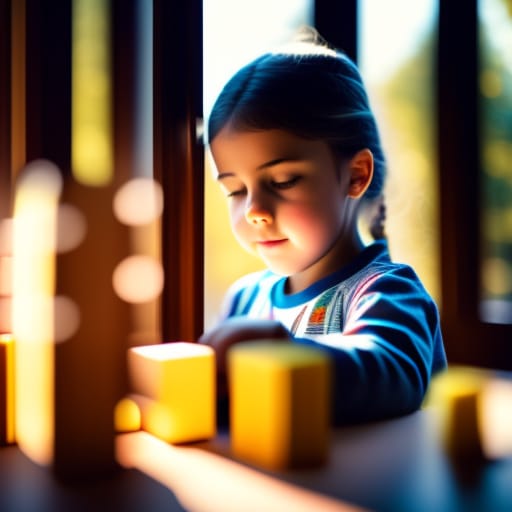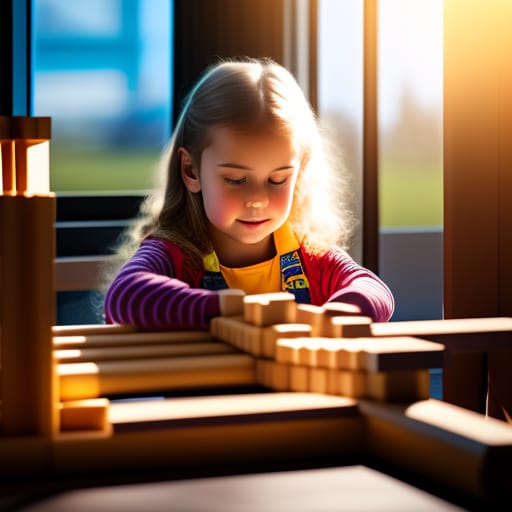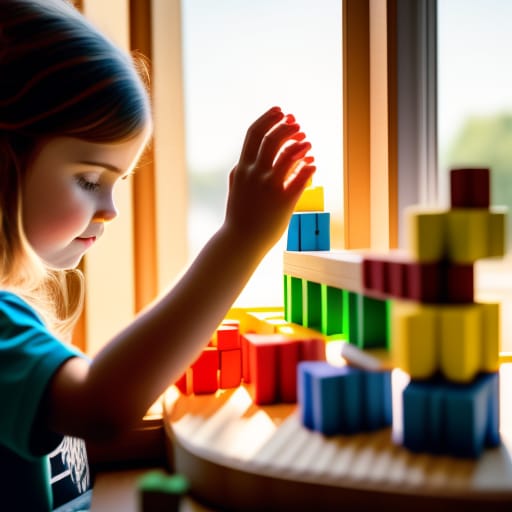Cardboard blocks are a classic toy that has endless possibilities for fun and learning. Built from durable, eco-friendly materials, these simple blocks can inspire creativity, develop STEM skills, and encourage cooperative play. This beginner’s guide will explore the benefits of cardboard blocks and provide tips for using them to their full potential.

What Are Cardboard Blocks?
Cardboard blocks are construction toys made from stiff paperboard or cardboard. They come in a variety of shapes from basic cubes to triangular prisms, allowing children to stack and assemble them in different configurations.
Compared to plastic blocks, cardboard blocks offer some unique advantages:
- Durability: Made from thick, sturdy cardboard, these blocks are designed for robust play and can withstand being stacked, knocked down, and rebuilt over and over.
- Eco-Friendly: Crafted from recyclable and biodegradable materials, cardboard blocks are a sustainable toy choice.
- Safety: With no sharp edges or tiny parts, cardboard blocks are safe for even young children. Their lightweight design also prevents injuries.
- Affordability: Simple materials keep costs low, making cardboard blocks an affordable building toy.
With cardboard blocks ranging from small manipulatives to oversized, furniture-sized pieces, children of all ages can enjoy hands-on construction play.
The Benefits of Cardboard Blocks
On the surface, cardboard blocks offer fun, open-ended construction play. But these simple toys provide so much more. Here are some of the key benefits of cardboard blocks:
Develop STEM and Engineering Skills
With cardboard blocks, children can explore foundational concepts in science, technology, engineering, and math. As they balance and stack blocks, they learn about structural engineering, gravity, and spatial reasoning. When connecting pieces, they engage in design thinking and problem-solving.
Encourage Imagination and Creativity
The open-ended nature of cardboard blocks inspires creativity and imagination. Children are free to dream up endless possibilities – constructing buildings, vehicles, robots, forts, tunnels, and anything else they can imagine. This fosters innovative thinking and problem-solving.
Build Motor Skills
Grasping, lifting, and manipulating cardboard blocks develop fine and gross motor skills. The act of stacking and balancing pieces helps with hand-eye coordination. For younger kids, carrying and maneuvering large blocks builds strength.
Enhance Cooperation and Social Skills
Playing with cardboard blocks in groups teaches important social skills like sharing, turn-taking, collaboration, and communication. Children must cooperate to build shared structures, developing empathy and conflict resolution abilities.
Offer Hands-On Learning
Cardboard blocks provide tactile, interactive learning. Active, hands-on play results in greater knowledge retention compared to passive screen time. Letting kids touch, build, and learn through experience fosters cognitive growth.
With all these benefits, it’s easy to see why cardboard blocks have stood the test of time!
Types of Cardboard Blocks
Cardboard blocks come in a diverse range of sizes, shapes, and styles to suit different ages and interests:
Basic Unit Blocks
- Description: Small, simple cardboard cubes ranging from 1-3 inches.
- Benefits: Allow for fine motor skill development and complex structures. Easy to transport and stack for storage.
- Age Range: Toddlers, preschoolers.
Jumbo Blocks
- Description: Large blocks ranging from 4-12 inches square. Sturdy and lightweight.
- Benefits: Enable building at a bigger scale, cooperative play. Promote spatial skills and STEM learning.
- Age Range: Preschoolers, early elementary.
Oversized Building Blocks
- Description: Giant, furniture-sized blocks from 1-3 feet square. Often made from recycled cardboard.
- Benefits: Allow for life-size structures and STEM learning. Make dramatic play more immersive.
- Age Range: Early elementary and up.
Interlocking Blocks
- Description: Blocks with tabs, holes, or magnets that connect.
- Benefits: Promote STEM and construction skills. Allow building layered, complex structures.
- Age Range: Elementary school ages.
Themed Block Sets
- Description: Blocks are designed around topics like architecture, transportation, and animals.
- Benefits: Spark imagination and interest in specific subjects. Make learning more engaging.
- Age Range: All ages.
With this assortment of cardboard blocks, there are endless options for building and playing.
Cardboard vs. Wooden vs. Plastic Blocks
While cardboard blocks offer many benefits, how do they compare to more traditional wooden and plastic blocks? Here’s an overview:
Key Takeaways
- Cardboard blocks win for sustainability, safety, and price.
- Wooden blocks offer warmth and traditional appeal but cost more.
- Plastic blocks are affordable but lack eco-friendliness.
Ultimately, cardboard blocks strike a great balance between durability, versatility, and sustainability. The eco-friendly materials and lower cost make them accessible for classrooms, daycares, and budget-conscious families.
Educational Benefits of Cardboard Blocks
Beyond just being fun toys, cardboard blocks offer rich educational benefits. Here are some of the key skills students develop when playing with cardboard blocks:
Develop STEM Skills
- Understand engineering and physics concepts like gravity, balance, and stability
- Apply math and spatial reasoning to stack blocks
- Use design thinking and critical analysis to create structures
- Experiment with concepts like scale, shape, and weight
Enhance Creativity
- Inspire open-ended play and limitless possibility
- Exercise imagination to build elaborate structures
- Collaborate creatively to find solutions
Improve Motor Skills
- Develop hand-eye coordination in grasping, moving, and placing blocks
- Build strength and control through lifting and carrying
- Gain practice with fine motor manipulation by precision stacking
Encourage Cooperation and Communication
- Take turns sharing blocks and ideas
- Verbalize plans and instructions
- Collaborate toward a common goal
- Provide peer feedback and guidance
Enable Tactile, Kinesthetic Learning
- Gain understanding through hands-on experience
- See and feel concepts like balance and gravity
- Retain knowledge through active play
Introducing cardboard blocks into the classroom provides an engaging way to foster important skills in STEM, creativity, collaboration, and communication. The versatile blocks align with key educational principles in constructivism, Reggio Emilia, and more.

Top 5 Cardboard Block Activities and Challenges
Ready to get the most out of your cardboard blocks? Try these fun challenges and activities that encourage learning through play:
1. Build the Tallest Tower
This classic block challenge tests engineering skills. See who can build the tallest freestanding tower before it topples over! Introduce concepts like the width of the base, weight distribution, and center of gravity.
2. Create Imaginary Architecture
Let kids’ creativity run wild by designing dream houses, castles, and buildings. Use themed blocks and accessories to add details like roads, trees, and figurines. Develop spatial reasoning skills by designing floor plans and models.
3. Conduct a Block Test
How much weight can different structures hold? Conduct experiments to find out! Test concepts like shapes, angles, balance, and distribution of force. Introduce the scientific method by asking a question, forming a hypothesis, testing it, and collecting data.
4. Build Bridges
Challenge kids to span gaps and build bridges from block to block or table to table. They’ll learn about the forces involved and how different shapes lend strength and stability to bridges.
5. Play Block Bingo
Call out block attributes like “Find two red cubes and stack them on a blue rectangular prism.” This helps develop listening skills, spatial reasoning, and color/shape recognition.
Keep block play fresh and exciting by setting fun challenges like these tailored to different ages and skill levels.
Cardboard Blocks for Open-Ended, Cooperative Play
Unlike toys with fixed uses, cardboard blocks lend themselves to open-ended, imaginative play. And playing collaboratively develops key social skills. Here are some tips to encourage engaging group play:
- Let kids lead: Step back and let them dream up ideas, plans, and rules for building.
- Add props: Introduce dolls, cars, signs, and other accessories to inspire more dramatic play.
- Create roles: Suggest roles like architect, contractor, or inspector but let kids assign duties.
- Have a materials station: Provide blocks, connectors, writing tools, sticky notes, and other supplies for easy access.
- Offer challenges: Present fun goals like “Build a house for the doll family” but leave solutions open.
- Encourage teamwork: Remind kids to share ideas, take turns, compromise, and assign tasks.
- Be an observer: Watch how kids interact and take note of the skills they demonstrate.
An unstructured approach allows cardboard blocks to flex kids’ imaginations and social skills. Observe and offer gentle guidance when needed.
Fun Cardboard Block Projects for Kids
Beyond freeform building, structured block projects teach valuable skills. Try these engaging ideas:
Cardboard City
Design an entire city with houses, businesses, parks, streets, and more. Bonus: create subway tunnels and bridges to connect it all!
Space Station
Invent fantastical spaceships, control rooms, and planetary bases. Add toy astronauts and robots to bring the space station to life.
Marble Run
Engineer ramps, chutes, and obstacles to send marbles on an exciting roller coaster ride from top to bottom.
Animal Habitats
Construct natural homes and environments for plastic animals. Include terrain, plants, caves, and accessories.
The sky’s the limit for inventive projects! Display finished structures like a mini museum.
The Future of Cardboard Blocks
Looking ahead, what innovations may be in store for cardboard blocks? Some possibilities include:
- New modular shapes: Blocks with curves, slopes, frames, and moving parts could enable more lifelike structures.
- Digital integration: Blocks could incorporate lights, sounds, or sensors for added interactive play.
- Sustainable materials: Blocks made from recycled and plant-based materials could reduce waste.
- Affordable large-scale blocks: Manufacturing advances might allow bigger blocks at lower prices to make construction play more immersive.
- Architectural applications: With their eco-friendliness, cardboard blocks have the potential for real-world building applications. Sustainable housing or disaster relief shelters made from durable cardboard could provide temporary refugee housing quickly and affordably.
As a toy material, cardboard continues to have exciting possibilities. Cardboard blocks’ sustainable nature, ease of recycling, and imaginative play value will no doubt make them a staple toy for future generations.

The Takeaway: Why Cardboard Blocks Should Be in Every Classroom and Playroom
As this beginner’s guide has shown, humble cardboard blocks offer tremendous developmental benefits. Their open-ended play value sparks creativity and keeps kids engaged through hands-on learning. As an eco-friendly, budget-friendly material, cardboard makes construction toys accessible for all.
So bring on the building! Introduce cardboard blocks to classrooms, daycares, and playrooms to inspire the innovators and master builders of tomorrow. Just make sure to save those leftover boxes for the ultimate DIY sustainable toy.
Additional Resources on Cardboard Blocks:
10 Awesome Cardboard Construction Projects for Kids
Teaching STEM with Cardboard Blocks
Benefits of Block Play from Zero to Three
Frequently Asked Questions
Looking to learn more about using cardboard blocks for play and education? Here are answers to some common questions.
What are the best cardboard blocks for toddlers?
For toddlers, opt for small unit blocks or jumbo blocks around 4 inches square. The larger pieces are easier for little hands to grasp and stack. Choose blocks with rounded edges for safety.
What makes cardboard better for blocks than wood or plastic?
Cardboard blocks win for sustainability, safety, and price. They provide the durability needed for construction play without the environmental impact of plastic or the expense of wood. Cardboard’s natural lightness also makes large blocks easier for kids to handle.
How do you make cardboard blocks more durable?
Look for blocks made from heavy card stock, chipboard, or laminated cardboard for maximum sturdiness. Store blocks properly when not in use to prevent moisture damage. Avoid prolonged water exposure during play. Reinforce block corners with tape for extended life.
Why are oversized cardboard blocks good for learning?
Oversized building blocks allow kids to build on a grander, real-world scale. This promotes STEM and spatial learning as children problem-solve to construct larger structures. Giant blocks also enable more immersive roleplay and cooperative building.
Can you build real furniture out of cardboard blocks?
With thick, reinforced cardboard and strong adhesive, cardboard blocks can be used to create real usable furniture. DIYers have built cardboard block chairs, tables, sofas, and more! Use interlocking blocks and strategic architecture to design sturdy, functional furniture on a budget.